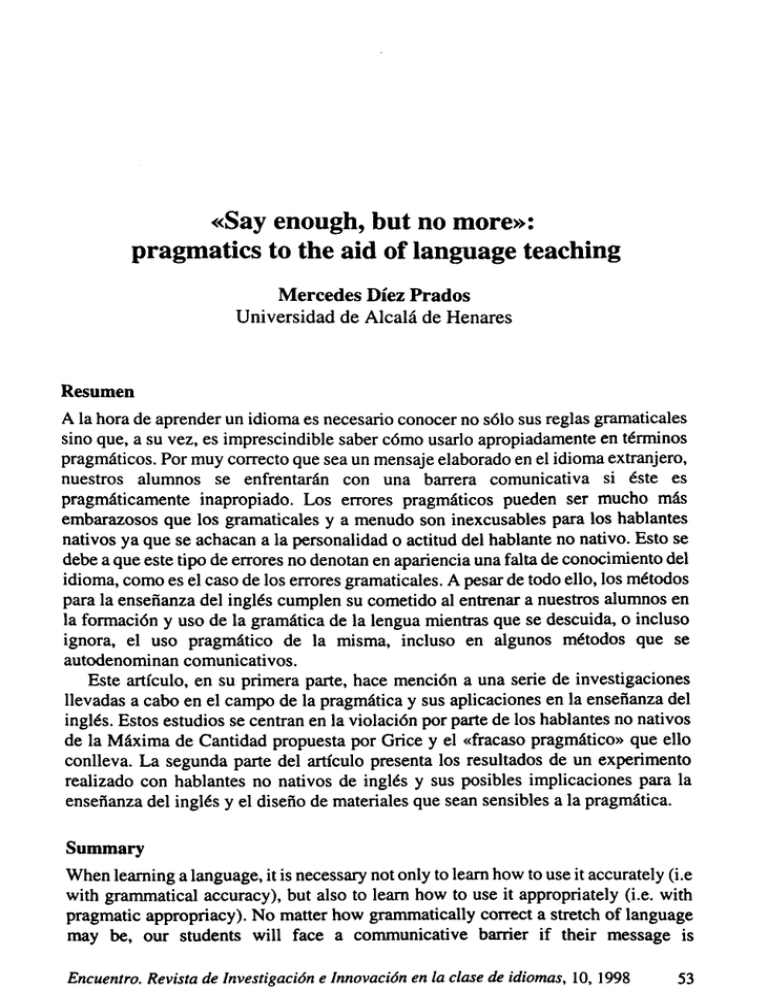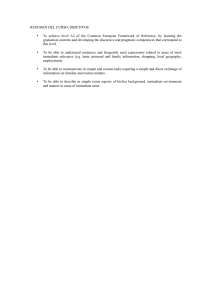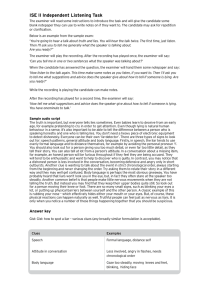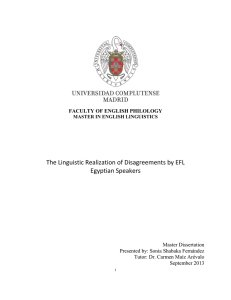Say enough, but no more»: pragmatics to the aid of language teaching
Anuncio

«Say enough, but no more»: pragmatics to the aid of language teaching Mercedes Diez Prados Universidad de Alcalá de Henares Resumen A la hora de aprender un idioma es necesario conocer no sólo sus reglas gramaticales sino que, a su vez, es imprescindible saber cómo usarlo apropiadamente en términos pragmáticos. Por muy correcto que sea un mensaje elaborado en el idioma extranjero, nuestros alumnos se enfrentarán con una barrera comunicativa si éste es pragmáticamente inapropiado. Los errores pragmáticos pueden ser mucho más embarazosos que los gramaticales y a menudo son inexcusables para los hablantes nativos ya que se achacan a la personalidad o actitud del hablante no nativo. Esto se debe a que este tipo de errores no denotan en apariencia una falta de conocimiento del idioma, como es el caso de los errores gramaticales. A pesar de todo ello, los métodos para la enseñanza del inglés cumplen su cometido al entrenar a nuestros alumnos en la formación y uso de la gramática de la lengua mientras que se descuida, o incluso ignora, el uso pragmático de la misma, incluso en algunos métodos que se autodenominan comunicativos. Este artículo, en su primera parte, hace mención a una serie de investigaciones llevadas a cabo en el campo de la pragmática y sus aplicaciones en la enseñanza del inglés. Estos estudios se centran en la violación por parte de los hablantes no nativos de la Máxima de Cantidad propuesta por Grice y el «fracaso pragmático» que ello conlleva. La segunda parte del artículo presenta los resultados de un experimento realizado con hablantes no nativos de inglés y sus posibles implicaciones para la enseñanza del inglés y el diseño de materiales que sean sensibles a la pragmática. Summary When leaming a language, it is necessary not only to leam how to use it accurately (i.e with grammatical accuracy), but also to leam how to use it appropriately (i.e. with pragmatic appropriacy). No matter how grammatícally correct a stretch of language may be, our students will face a communicative barrier if their message is Encuentro. Revista de Investigación e Innovación en la clase de idiomas, 10, 1998 5 pragmatically inappropriate. Pragmatic errors can be far more embarrassing than grammatical ones and are less excusable on the part of native speakers: the leamer's personality or attitude could be misjudged as this type of errors do not apparently denote lack of linguistic knowledge. However, most teaching methods do afinejob in training our students in the grammatical usage of the language, whereas the pragmatic use is very often neglected or, simply, ignored, even in the case of some socalled communicative materials. This paper reviews, in afirstpart, research done in thefieldof pragmatics and their practical applications in the discipline of language teaching. The studies revised focus on the violation by non-native speakers of Grice's Maxim of Quantity and the pragmatic failure that arises as a consequence. The second part of the paper presents the results of an experiment carried out with non-native speakers of English and the implications that this could have both for teaching English and for designing materials that are sensitive to pragmatics. 1. Introduction The aim of this paper is to apply the pragmatic theoretical framework elaborated by Grice on the principies that govem conversation to the language produced by nonnative speakers of English. Thus, let us recall the building blocks of this theory, that is, the Cooperative Principie and its Maxims. According to Grice, conversation partners will cooperate in order to communicate effectively; on the one hand, the speaker will elabórate his/her messages in such a way that they will be easily interpretable for the hearer and, on the other, the hearer will do his/her best to interpret the speaker's utterances. In this fashion, the speaker will elabórate his/her message sticking to the Maxims of Quantity (i.e. appropriate length), Quality (i.e. truth), Relevance (i.e. pertinency) and Manner (i.e. clarity). A fuller explanation of these concepts does not seem necessary since it can be found in numerous publications on the subject, should any reader be interested (cfr. Levinson, 1983; Leech, 1983; Escanden, 1993; Renkema, 1993, to mention just a few). Three more concepts from Grice's model should be taken into account since they are necessary for the understanding of our main issue: The pragmatic failure that leamers of English frequently make. These concepts are violation and flouting of a maxim and the consequent conversational implicature that occurs as a result. When speakers do not follow the maxims purposefully, we say that they viólate them; if the violation is only apparent, that is, if the speaker deliberately ignores one of the maxims, s/he does so with a particular communicative intention and s/he is, thus, 54 flouting that maxim. In fact, since the hearer is cooperative and assumes the speaker to be so, s/he recognizes the speaker's intention and tries to draw the pertinent implicature out of the apparently inappropriate utterance. Furthermore, in order to fully understand the kind of error we are focusing on in the present paper, we need to introduce another distinction within the kinds of maxim violations, which is produced when a speaker does not stick to the maxims, not because s/he is trying to achieve a given communicative aim but because s/he simply ignores the dimensions of the maxim. I am referring to the dichotomy introduced by Blum-Kulka and Olstain between intentional and unintentional violations of a maxim. According to these authors, when a speaker intentionally violates a maxim, he is not actually violating it but flouting it with communicative purposes. However, for such flouting to be interpreted as such and the subsequent implicature to be drawn, the speaker and the hearer, apart from being cooperative, must share the same cultural and linguistic norms. Otherwise, when these norms are not shared, unintentional violations may arise. This kind of violations does not allow the drawing of implicature but they are taken at face valué and are considered as a lack of cooperation on the part of the speaker, although s/he does not break the maxim(s) purposefuUy. Although it is a useful distinction, I do not think it is fully accurate, since it does not contémplate that speakers may viólate a maxim intentionally with no communicative end (i.e. that the speaker is being uncooperative). When speakers viólate a maxim unintentionally, pragmatic failure takes place. Blum-Kulka and Olshtain (1986) define the concept of pragmatic failure as a communication problem that «occurs whenever two speakers fail to understand each other's intentions» (p. 166). They pinpoint that such miscommunication can occur between conversational partners with the same linguistic and cultural backgrounds but that it is obviously more likely to happen between speakers from different origins and languages. The term pragmatic failure was, in fact, coined by Thomas (1983), as Blum-Kulka and Olshtain note in their article, to denomínate those misunderstandings that are due to the the second language leamer's lack of awareness of the target language pragmatic aspects. 2. Pragmatic failure and the Maxim of Quantity A. K. Vamarasi (1990) states Grice's Maxim of Quantity in an informal way as «say enough, but no more» and points out that it may be interpreted differently by each 55 culture. Vamarasi agrees on the fact that Grice's principie and maxims are universal but notíces that the interpretation of those principies is culturally bound, that is, culture specific. Regarding the Maxim of Quantity, what is enough for an English speaking person may not be enough for an Spanish or a Japanese one and the same would hold true for the rest of the maxims. Too much and too little are, therefore, relative concepts. Vamarasi (1990) presents in his article some theoretical assumptions that are enlightening in order to understand some of the causes which may be responsible for intercultural unintentional violations of the Maxim of Quantity. FoUowing Hall (1981), he distinguishes two cultural groups according to their interpretation of the Maxim of Quantity: Low Context and High Context cultures. The former assign great valué to talking and communicate mostly through verbal language, that is, they communicate mainly through words; the latter, for whom talking is less valuable, rely heavily on the context for the interpretation of their messages, being part of it merely implied instead of put into words. Among the Low Context cultures, Vamarasi places the Swiss and the Germán and, among the High Context ones, the American Indian, the Japanese and the Chínese. Others share characteristics with both Low and High Context culture, among them, the American one, which is placed more closely toward the Low Context group but showing some characteristics of the High Context one. It seems desirable that leamers of a foreign language be aware of the group to which the second language culture is assigned to. The foUowing characteristics can be observed in High and Low Context cultures, which can serve as a guide when deciding to which group a given culture belongs. In High Context cultures information is widely shared and people are deeply involved; the members are rooted in the past and, therefore, reluctant to change; they are closed as a group, making greater distinctions between insiders and outsiders; they commit to completing an action chain and, consequently and they tend to be polychronic (i.e.not time-oriented). With regards to Low Context cultures, members occupy the opposite extreme of the continuum: they are highly individualized, somewhat alienated and fragmented; they are unstable and, as such, feel less bound to complete action chains (this can be seen in the instability of their institutions, e.g. marriages commonly end in divorce);finally,they are monochronic (very highly time-oriented). Regarding their messages, High Context members convey most of their information either in the physical context or this is intemalized in the explicit part, talking around 56 the main point of a subject and expecting the interlocutor to supply that main point. Low Context members lócate the mass of the Information in the explicit code itself; they view with suspicion and mistrust those people who do not speak directly to the point. Vamarasi mentions the problems faced by businessmen from different cultures in their transactions. In the case of American and Japanese, the former pay more attention to the verbal message itself and less to the context, while the latter are more sensitive to movements and environmental aspects not noticed by others. In Blum-Kulka and Olshtain's terms (1986), pragmatic failure would take place in such business encounters since this problem «occurs whenever a speaker fails to Uve up in terms of appropriate adherence to regulative maxims» (p. 168) and each group of speakers adhere, in the case we are dealing with, to the norms established by their cultures. The implications for ELT can be undoubtedly drawn from this illustration. In the same way, the study carried out by Blum-Kulka and Olshtain pinpoints the different interpretations of the maxims by speakers from different linguistic and cultural backgrounds. They carried out an experiment on utterance length which involved native and nonnative speakers of different languages. In their experiment, they focused on speech acts, precisely those of request and apology and found that native speakers got their message across using less words than nonnatives, which is somewhat surprising if we consider that leamers of the language would tend to use the mínimum amount of wording possible due to their proficiency restrictions. BlumKulka and Olshtain found the following sources for potential pragmatic failure in their experiment related to utterance length: 1. Verbosity per se, according to which the nonnative speaker uses more words than the native to perform a similar pragmatic act. This kind of pragmatic error causes impatience on the part of the native speaker, who judges the nonnative speaker's utterance as too lengthy. The examples provided illustrate this point: Situation: The subject is asked to assume the role of a professor and phrase a request directed to a student to present his/her paper a week earlier than scheduled. These are the utterances provided, in the first case, by a Hebrew speaker in English and, in the second one, by an American subject: (S15) «I went over the material we will study in the next weeks and I rather like to have your lecture next week, if it's possible and if you can be ready». 57 (S15) «Lcx)k, your presentation would be perfect for next week's session. Do you think you could have it ready?» (p.l75) 2. Overinformativeness, by which the nonnative speaker provides more information than necessary on the background, the preconditions, the reasons and the justifications related to the context in which the request is embedded. In this case the leamer could be violating the Maxim of Relevance as well as the Quantity one. Should part of the utterance be judged as irrelevant, the forcé of the speech act might weaken. This is exempHfied as follows: Situation: A poHceman asks a woman driver to move her car, where it obstructs the way to a house on fire: «You see there is afireand how is it that your car is parked in a place we need. Please move quickly». (p.l76). According to Blum-Kulka and Olshtain, the reason that impulses leamers to overinform is the lack of confidence that their message is going to get across: «the less confident you are that you can get the meaning across, the more words and contextual information you use», (p. 176). 3. Double messages, caused by the use of several contradictory modifiers attached to the request. As an example: Situation: A student asking his/her roommate to clean the kitchen, which the latter had left in a mess the night before. The former role is played by the subjects who makes the following request: Please start cleaning the kitchen whenever you have time, and I prefer right away». This lengthening of the request by adding the last modifier (I prefer right away) poses a contradiction with the previous one (whenever you have time), which obviously infringes the Maxim of Relevance. It can be noticed that in the two latter cases, not only is the quantity of the utterance faulty but also its relevance. This is due to the fact that speakers, as Blum-Kulka and Olshtain claim (p. 171), select both the amount and the type of modification according to the quantity and relevance of the contextual information they judge necessary for the realization of a given act. Therefore, both maxims are potential sources for pragmatic failure. The authors observed that this unintended violation of the Maxim of Quantity was particularly common among high intermedíate and advanced students, who feel more comfortable with their knowledge of the language but are worried about the 58 effectiveness of their speech acts; they counteract this concern with verbosity. Low level students, however, are closer in number of words per utterance to nati ve speakers of the language, precisely because of their limited knowledge. 3. Results from a replication of Blum-Kulka and OIshtain's experiment I replicated these author's experiment with a group of intemational students at the University of lUinois (U.S.A.) as the nonnative subjects and a group of American students for comparison; they were thirty in total and were all part of a gradúate program: They were enrolled in the second year of a master's degree in the Teaching of EngUsh as a Foreign Language. In order to enter this program, intemational students must have taken the TOEFL exam and got a 600 score or higher; apart from this, they are given an entry placement exam and those who do not fully qualify must enroll in extra ESL classes. These two filters as well as the fact of being carrying out a maste"s degree in an English department guarantees that the subjects under study have a high command of the English language. This should be borne in mind when interpreting the results. Following Blum-Kulka and OIshtain's guidelines, I collected the data through a questionnaire, based on their discourse completion test, although I introduced minor changes'. This questionnaire consisted of five apology situations: 1. A student asking his/her roommate to clean the kitchen, which the latter had left in a mess the night before; 2. A student asking a fellow student to lend him/her the notes from a class s/he had missed; 3. A student asking people living on the same street for a ride home; 4. A professor asking a student to present his/her paper a week earlier than scheduled; and 5. A policeman asking a driver to move her car. Blum-Kulka and Olshtain analyzed each of the discoursefilie rs^, as they cali them, sequentially, on the one hand, that is to say by delimiting that part of the sequence which could potentially serve in itself to realize the act (called the Head Act) and ' These changes include ommitting the introduction to the request they propose and changing the person of the speaker in the simulated conversations from third person to first person. The first change was motivated because I thought an introduction to the request could lead the subjects in their responso and the second one was introduced in order to personalize the requests, which would help them get involved in the situation. ^ This term stands for the utterance provided by the informants to fiU in the missing part (i.e. the speech act they are supposed to perform, in this case the request they are asked to make). 59 functionally, on the other hand, by classifying each of the parts noted in the sequence in terms of pragmatic criteria, depending on the request strategy used (depending on their degree of directness, the requests ranged from the hint, the least direct, to the imperative, the most direct). The other elements that are not part of the request per se were divided into extemal and internal modification. The former occurs within the Head Act (e.g. picase, by any chance), the latter consists of added elements to the Act, such as justifications or reasons for the request. Of all elements studied, Blum-Kulka and Olshtain only found differences in behaviour between native and nonnative speakers regarding amount and type of extemal modification. They found that nonnative speakers used less internal modifications than natives (27% against 31.5%), although the difference is not statistically significant. On the contrary, the difference in use of extemal modification proved significant, being the nonnative speakers the ones that showed a higher degree of modification (55.5% against 40%) With regards to my experiment, internal modification was practically non-existent in both groups, and, consequently, I decided to ignore it. However, extemal modification was widely used and in a more balanced way between native and non-native speakers (70.6% in the case of nonnatives and 68% among natives). This difference in results between Blum-Kulka and Olshtain's experiment and mine seem to be depicting different states of affairs. When dealing with the kinds of extemal modification, Blum-Kulka and Olshtain distinguish seven categories: preparation, availability, grounders, disarmers, cost minimizers, combinations of the previous ones and others''. The distribution of use of the different types of extemal modifiers is different in both experiments, too. Once more, in Blum-Kulka and Olshtain's, a clear distinction can be observed between native and nonnative speakers, whereas in mine both groups use the same amounts and kinds of modifiers (see Table 1). Nevertheless, I should pinpoint my concern regarding the reliability of these last results, due to the fact that the sixth category (i;e. combinations of the above modifiers) is somewhat ambiguous: it does not clarify what modifiers were in combination or the number of them (i.e. the combination is in principie unlimited). This ambiguity, thus, obscures what the study is set to demónstrate: the length of ^ The only categories defmed in Blum-Kulka and Olshtain's study are grounders and disarmers. The former include reasons and justifications for the request, the latter are called as such because they disarm the hearer from a potential tendency to refuse, by expressing the awareness of his/her needs. 60 utterance length and its differences between native and nonnative speakers. It must be noticed that the whole categorization is rather ambiguous; the tagging of the modifier categories was not always easy to make. Some sort of interrater reliability for the assignment of tags would have been desirable although not possible in the present study. N NN B&O Diez B&M Diez n = 81 n=13 n = 48 n=13 Preparation 7.4 _ 6.1 _ AvailabiUty 2.5 _ 3.4 _ Grounders 23.5 46.1 31.1 53.8 Disarmers 1.2 _ _ _ Cost minimizers 38.3 7.8 17.6 . Combination 24.7 46.1 41.2 46.2 Others 2.5 - 0.6 - Types of modifiers Table 1 When comparing the amount of use of modifiers by native speakers in both experiments, results are also diverse: in my replication, modifiers are present in most of the native speakers request formulations in my study, whereas the opposite case hold true for Blum-Kulka and Olshtain's (68% and 40%, respectively). Conclusions and pedagogical implicatíons As the differences in results across analyses is obvious, the reason for that discrepancy should be investigated. There are three factors that could account for it: 1) The imbalance in terms of number of informants; 2) the data collection method and; 3) the analysis of the data. As far as the number of subjects is concemed, mine is a much smaller sample, however, that alone should not be enough to consider it valueless. 61 Conceming the method of collection, Blum-Kulka and Olshtain, as it was mentioned above, provided the first part of the request, which I omitted in my discourse completion test. If we analyze the example they provide in a footnote (p. 178)'', we can observe that such introduction could be playing the role of a modifier (in this particular case, it could be interpreted as a grounder). If all introducers could be analyzed as such, informants might have felt no need for providing another one, and, thus, this could be the source for the difference in results in both studies (let us recall that in my analysis natives used more modifiers in general than natives in Blum-Kulka and Olshtain's study). Finally, the diffículties in the analysis (i.e. assignment of tags to modifiers) might have influenced on the results as well. Probably, these three factors altogether are responsible for the lack of agreement between experiments. To counteract the discrepancies found in my replication and get a clearer picture regarding what should be the desirable length of an utterance I carried out a further analysis which was counting the number of words per utterance, understanding by word every graphically separated minimal unit of discourse. Again, the difference in number of words between native and nonnative speakers was minimal (17 and 16.1, respectively). This was not the case in Blum-Kulka and Olshtain, who recorded an average of 8.3 words per utterance in the case of native speakers and of 10.1 in nonnative speakers' utterances. It should be noticed that utterances in my study were considerable longer than in Blum-Kulka and Olshtain's; this could have been conditioned by the fact that I did not provide introductions to the requests demanded. This general equality in results between both groups of informants in my study may be due to their English proficiency. The requests analyzed do not suffer from the kinds of pragmatic failure mentioned by Blum-Kulka and Olshtain of verbosity, overinformativeness or double messages. Nevertheless, further replications are suggested with different groups of students and, if possibly, taking native speakers as a reference group. The concept of modifier as developed by Blum-Kulka and Olshtain, although it is difficult to grasp as an analytical tool, it is an attractive one and certainly one to consider when teaching how to make requests in a foreign language. It is pedagogically appropriate for leamers to know the degree of modification they should use in order to redress their face threatening acts (cf. Brown and Levinson, 1978), in * The request needs to be filled in following this introduction: «John: Larry, EUen, and Tom are coming for dinner tonight and I'U have to start cooking soon;...». 62 this case, their requests. At the same time, this kind of comparative studies between native and nonnative performances help teachers and students get an idea of what the uses of these pragmatic strategies are, although almost identical studies can give different results, as it was shown. The same sort of conclusions can be drawn when trying to find practical applications of this kind of studies in materials writing: Writers should try to design materials that contémplate the pragmatic use of the language and that do not train students to overuse request modifiers, since the fact that their utterances are long stretches of language does not guarantee their communicative success. Quite on the contrary, they may push them to commit pragmatic failure. Bibliography Blum-Kulka, S. and Olshtain. 1986. «Too many words: length of utterance and pragmatic failure». Studies in Second Language Acquisition, 8, pp. 165-179. Brown, P. and Levinson, S. 1978. Politeness: Some Universals in Language Usage. Cambridge: Cambridge University Press. Escanden, M.V. 1993. Introducción a la Pragmática. Barcelona: Anthropos. Hall, E.T. 1981. Beyond Culture. Carden City: Anchor Books. Leech, G.N. 1983. Principies of Pragmatics. London: Longman. Levinson, S. 1983. Pragmatics. Cambridge: Cambridge University Press. Renkema, J. 1993. Discourse Studies. An Introductory Textbook. AmsterdamPhiladelphia: John Benjamins. Thomas, J. 1983. «Cross-cultural pragmatic failure». Applied Linguistics, 4, pp. 91112. 63



